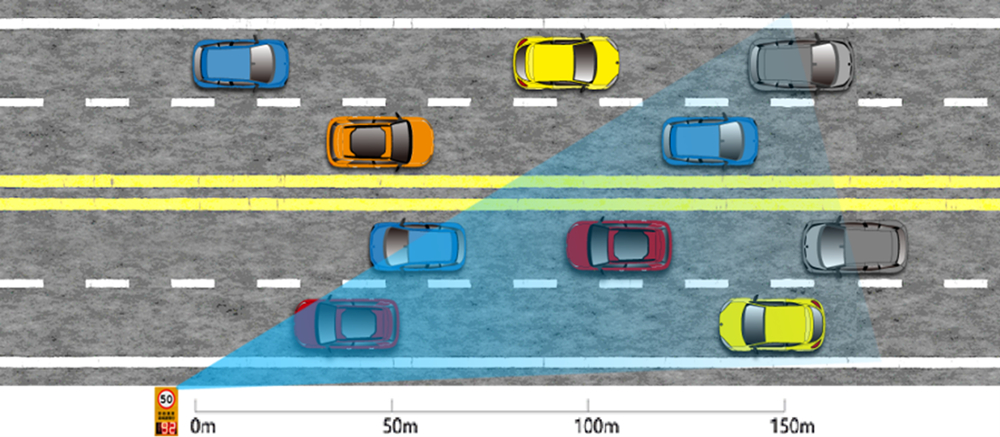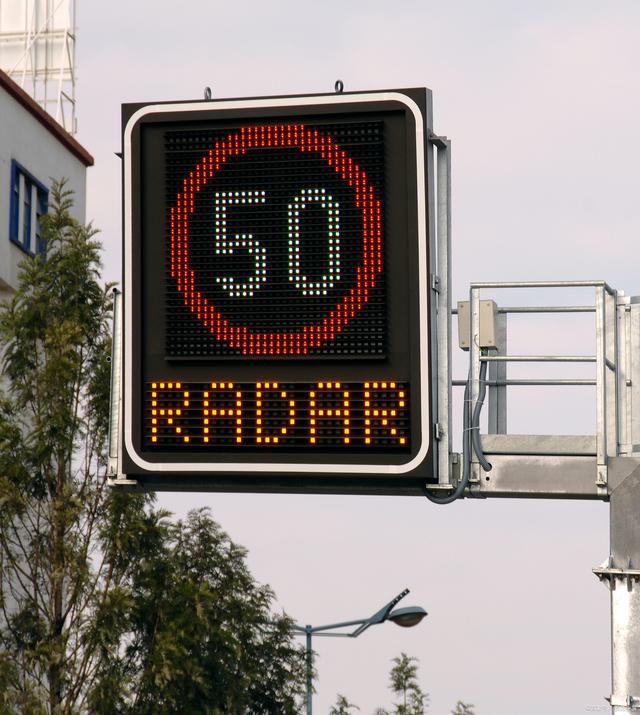Radar speed sign: diverse application scenarios and advantages
With the booming development of the transportation industry, the number of vehicles on the road is increasing, and the complexity of traffic management is growing day by day. As an important component of transportation infrastructure, radar speed sign are no longer limited to traditional speed warning functions, but have demonstrated diverse application values in many fields. It is like an “intelligent guardian” in the transportation network, constantly guarding the smoothness and safety of roads. Exploring it in depth can help tap into greater potential in traffic management.
1、 The forefront defense line to ensure traffic safety
Road sections with frequent accidents
Specific sections of ordinary highways, such as continuous bends, steep slopes, and intersections with obstructed visibility, have always been high-risk areas for accidents due to complex road conditions. Especially in mountainous areas, highways have dense bends, with some bends having extremely small curvature radii, resulting in significant blind spots for drivers. In the past, many drivers who were not familiar with the road conditions often encountered frequent collision accidents when passing through these bends due to their fast speed, which often prevented them from avoiding oncoming vehicles at the bends. After installing the radar speed sign on such road sections, it prominently displays the recommended speed limit for safe passage through bends several hundred meters in advance, such as a speed limit of 30 kilometers per hour, accompanied by prominent bend warning signs and flashing warning lights. Drivers can clearly see from a distance, giving them ample time to slow down early and smoothly navigate through curves. Reducing the accident rate greatly ensures driving safety.
Highway construction area
During road maintenance, expansion, and other construction activities on highways, the road conditions on the construction sections become complex and dangerous. On the one hand, the lane narrows and vehicles need to travel in parallel; On the other hand, there are often construction personnel and equipment operating around the construction area. The radar speed sign plays a crucial role at this time, gradually guiding vehicles to slow down several kilometers ahead of the construction section, and limiting the speed within an appropriate range based on the scale of the construction and the impact on traffic.
Response to adverse weather conditions
When encountering severe weather such as rainstorm, fog, ice and snow, the road conditions deteriorate sharply. The radar speed sign can be linked with the meteorological monitoring system to quickly respond. Once severe weather is detected, it will immediately switch to display the safe speed limit suitable for the weather, such as reducing the speed limit to 20 kilometers per hour or even lower in foggy weather, and activating the fog light warning function to remind the driver to turn on the fog lights and drive cautiously.

2、 Overview of Radar Speed Sign
Installation location
The installation location of the radar speed sign has been carefully planned to maximize its effectiveness. On highways, they are usually set up in prominent locations on both sides of the road at regular intervals (usually 5-10 kilometers), such as before and after interchanges, at the starting point of long downhill sections, near service area entrances and exits, etc. These places have frequent speed changes, and vehicles need to timely understand speed limit information to adjust their driving status. In terms of ordinary highways, key nodes such as bends, steep slopes, and intersections where accidents occur frequently will inevitably have its presence, warning drivers in advance to slow down. In urban roads, the surrounding roads of densely populated areas such as schools, hospitals, and commercial centers, as well as intersections on main roads and near bus stops, are common landing points for radar speed sign to ensure the safety of pedestrian and vehicle traffic and maintain traffic order.
Working principle
Currently, most radar speed sign use radar speed measurement technology. It is based on the Doppler effect, where the frequency of the reflected wave changes when the vehicle approaches or moves away from the speed radar. By measuring this frequency difference, the vehicle speed can be accurately calculated. The speed radar transmits the measured vehicle speed data to the control unit, which drives the display screen on the indicator board to update the speed limit information in real time according to the preset program, informing the driver of the safe driving speed on the current road section. Compared to other traditional speed measurement methods, radar speed measurement has the advantages of high accuracy, fast response speed, and continuous monitoring. It can adapt to complex and changing traffic environments and provide real-time accurate speed feedback to drivers.

3、 The driving force behind optimizing traffic flow
Highways
Radar speed sign are crucial for maintaining smooth traffic flow on highways due to their fast speeds and high traffic volume. During normal traffic hours, it sets reasonable speed limit standards based on the designed speed and traffic flow conditions of the road section. Generally, the main line has a speed limit of 100-120 kilometers per hour to ensure efficient driving of vehicles and avoid danger caused by individual vehicles speeding. During peak traffic periods, such as holiday travel, some road sections are prone to congestion. Radar speed sign collaborate with intelligent transportation systems to monitor congested road sections in real time, reduce speed limits appropriately in front of the source of congestion, guide vehicles to slow down in advance, queue in an orderly manner, prevent vehicles from braking suddenly and changing lanes frequently at congested points, reduce the risk of accidents, and ensure smooth traffic flow.
Ordinary urban arterial roads
Urban arterial roads connect various important areas with busy traffic. During the rush hour on weekdays, there is a lot of traffic congestion in the direction of entering the city, while the direction of leaving the city is relatively relaxed. Radar speed sign, combined with intelligent traffic control, reduce the speed limit to 30-40 kilometers per hour in congested urban areas based on real-time traffic flow, promoting smooth and slow driving of vehicles, reducing emergency stops and starts, and alleviating congestion; When the direction out of the city is clear, the speed limit should be increased to 50-60 kilometers per hour to accelerate the evacuation of out of city traffic. During non peak hours, restore normal speed limits to ensure full utilization of road resources.
Park roads
Within various industrial and technological parks, there are numerous enterprises, and logistics vehicles and employee commuting vehicles frequently shuttle back and forth. The road conditions in the park are complex, with many intersections and occasional pedestrians. The radar speed sign at the entrance of the park clearly indicates the overall speed limit of the park and reminds external vehicles to pay attention to safety. Dynamically adjust speed limits on internal main roads based on the characteristics of pedestrian and vehicular traffic at different times. During peak working hours, logistics vehicles enter and exit in a centralized manner, and the speed limit is appropriately reduced to ensure pedestrian safety; During the lunch break, the flow of people decreases, and the speed limit is moderately relaxed to improve logistics efficiency.
Surrounding areas of the school
During the morning and afternoon dismissal periods of school days, a large number of vehicles transporting parents to pick up and drop off students gather, and the flow of people is also very high, making the roads instantly congested. Radar speed sign play a crucial role in guiding traffic during this period. During school hours, the radar speed sign at the school entrance and surrounding main roads set the speed limit to 20 kilometers per hour to ensure students’ safe crossing of the road. At the same time, it can also be linked with the school’s schedule, enabling the speed limit mode half an hour in advance, giving parents and passing vehicles enough time to adapt. During the after-school hours, in addition to strict speed limits, signs can also be used in conjunction with traffic signals to implement tidal control over the lanes at the school entrance, creating dedicated temporary parking areas to guide vehicles to stop and leave immediately. Through this refined management, the traffic order around the school during peak commuting hours has been significantly improved, and congestion has been effectively alleviated.
4、 A silent mentor to enhance public transportation awareness
Developing daily driving habits
Drivers frequently come into contact with radar speed sign during daily travel, and over time, speed limit requirements gradually become a subconscious driving habit. Every time they see the speed limit number on the radar speed sign, drivers unconsciously adjust their speed, which constantly strengthens their awareness of obeying traffic rules. Taking novice drivers as an example, they may lack experience in speed control when they first hit the road, but through constantly encountering radar speed sign, they gradually learn to drive reasonably according to the speed limit requirements of different road sections, thus adapting to the road environment faster and reducing the potential risks caused by speeding. In the long run, radar speed sign are like a silent driving instructor, encouraging the public to integrate safe driving concepts into every trip.
New battlefield for traffic safety publicity
Some advanced radar speed sign have added electronic display screens, which not only display speed limit information, but also become a new window for traffic safety publicity. When the vehicle is waiting for a red light or passing slowly, the display screen scrolls to play traffic safety slogans, animated short films, local traffic accident case analysis, and other content. For example, displaying a video of an accident where a vehicle lost control and crashed into a guardrail due to speeding, accompanied by concise and powerful text reminders that “speeding is more dangerous than a tiger, safety is the only way home”, using visual impact to make drivers deeply aware of the dangers of speeding. This way of integrating publicity into daily travel scenarios greatly expands the coverage and effectiveness of traffic safety publicity, allowing traffic regulations and safety knowledge to be deeply ingrained in people’s minds.
